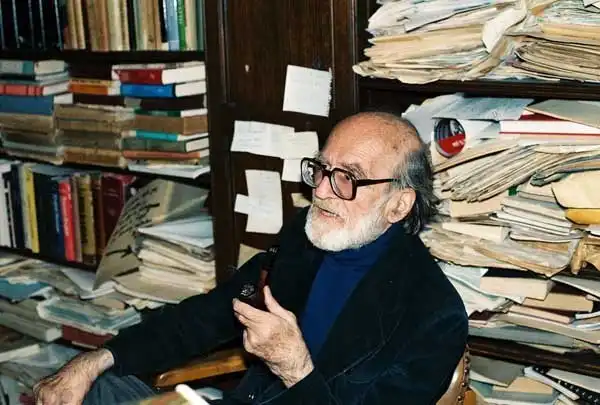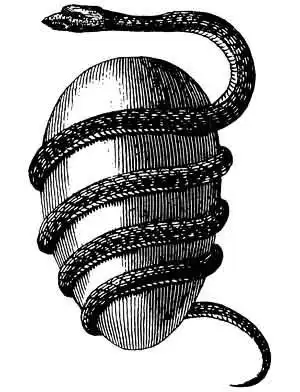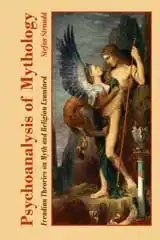Mircea Eliade
His theories about mythology and religion examined by Stefan Stenudd
In 1945 he moved to Paris, where he got acquainted with comparative mythology scholar George Dumézil, and started teaching comparative religion at the Sorbonne. His first meeting with Jung was in 1950, as Eliade started to attend the annual Eranos conferences in Switzerland. He gave lectures there regularly until 1967.[1] In 1958 he was appointed to head the University of Chicago History of Religions department, where he remained until his death in 1986. In addition to his teaching and extensive writing (mainly in the 1950s and 60s), he started the journals History of Religions and The Journal of Religion. His extensive work Histoire des croyances et des idées religieuses in three volumes was published between 1976 and 1983. An English translation, A History of Religious Ideas, followed shortly. He was the editor in chief of the Encyclopedia of Religion in 17 volumes, published in 1987, the year after his death. Eliade also wrote a number of novels, often with erotic and mythological components.
Other ArchetypesIn 1949, while still in Paris, Mircea Eliade published Le mythe de l’éternel retour: Archétypes et répétition (The Myth of the Eternal Return: Archetypes and Repetition), which was widely spread and appreciated. The English edition was published in 1954, without the subtitle.[2] Its slightly revised 1959 edition was titled Cosmos and History: The Myth of the Eternal Return, and the 1965 edition The Myth of the Eternal Return or, Cosmos and History. In the preface of the 1959 edition, Eliade writes that he considers it “the most significant of my books.”[3]Although the term archetype disappeared in the English title, it is prominently used in the text. But Eliade points out in the 1959 preface that he is not referring to the Jung archetypes. Instead, he compares his use of the term to that of the Spanish essayist Eugenio d’Ors, as a synonym for “exemplary model” or “paradigm,” which he means is the Augustinian sense of the term. He notices that Jung’s use of the term has become so established, other uses of it need to be explained or even avoided:
Accordingly, archaic man linked things and events to their archetypes in order to make them “real” in the sense of having a lasting significance, since “for archaic man, reality is a function of the imitation of a celestial archetype.”[6] In other words, the archetypes were deemed sacred, a concept Eliade was to explore more in later books. By regarding them as sacred, archaic man could trust their endurance:
For example, when discussing the archetype of the center of the world, such as the sacred mountain where heaven and earth meet, he states: “Every temple or palace and, by extension, every sacred city or royal residence is a Sacred Mountain, thus becoming a Center.” Also, it is regarded as “the meeting point of heaven, earth, and hell.”[8] Places given this significance can be found, but so can numerous temples and palaces that are not. Eliade is applying his own symbolism, not necessarily that of the people who built and inhabited those places. He speaks of the center of the world as “the earth’s navel, the point at which the Creation began,”[9] which leads him to this questionable reasoning:
2. Consequently, whatever is founded has its foundation at the center of the world (since, as we know, the Creation itself took place from a center).[10]
Not only that, but so many creation myths lack a central point for the beginning of creation, and simply could not have one. There is often a primordial sea, in which a center is hard to find, and then there is heaven, also lacking a center. The earth is rarely described as created from a central point. Usually, the whole of it appears at once. It is definitely more common that no specific place for the beginning of creation is pinpointed. It is not even the case in Genesis of the Bible. God begins by creating light in the primordial darkness, then day and night, then the firmament, and so on. No center, no certain spot from which the world grows. Nor can the Garden of Eden be called a center from which creation took place, since its appearance is late in the process. Eliade includes rituals in the pattern he proposes. They all have a divine model, an archetype, and “all religious acts are held to have been founded by gods, civilizing heroes, or mythical ancestors.”[11] Again, that is far from certain about them all, even considering the very broad definition of who would have done it. Many rituals around the world have no fixed origin, but are performed because of tradition. He includes dance in the same reasoning: “All dances were originally sacred; in other words, they had an extrahuman model.” By extrahuman he means they were presumed to have been created “in the mythical period, by an ancestor, a totemic animal, a god, or a hero.”[12] But every dance is not a sacred ritual, just as every song is not a hymn — nor is there reason to assume that archaic man believed so. People must have danced and sung before they started using such expressions in religious acts justified by mythical explanations. Claiming that it was all sacred ritual to archaic man makes no more sense than saying the same about the dancing and singing of modern man. Eliade takes his theory into the absurd, making our ancestors unable to relate to their world in any other way than religiously:
Still, there is truth to his model. We do tend to sort of glorify aspects of our lives as well as ourselves. Life and its components are given theatrical effects that make us appreciate and remember them. History is made up of extraordinary events and people, whereas the everyday things in between have faded away, as did the vast majority of anonymous persons never mentioned in history books. We do the same thing today, paying attention to places and persons we regard as remarkable, while the rest is little more than a blur. So, it can be said that we make some types into archetypes, ascribing particular importance to them. It is a completely conscious process, and it does not signify a longing back to some legendary primordial time. Nor does it mean that those archetypes are more real than other types — just fancier. It is questionable to assume that archaic societies were different from ours in this sense. They just had other explanations for it. It can be compared to how the word idol changes meaning when used for the present instead of the past. Traditionally it represented the worship of a deity, whereas today’s idols are worshipped but still regarded as human. The common denominator is the worship. It doesn’t need to be based on a religious belief, so we should not take for granted that it was to archaic man. The same can be said for rituals. We uphold many of them, even when they have no religious significance to us. They are, and were also for archaic man, first of all celebrations. To Eliade, rituals connected to the new year were expressions of the eternal return to the time of creation, whereby the world was created anew. But the cyclic behavior of nature was as evident to archaic man as it is to us. It happened with or without a ritual. Yet, it was something to celebrate, especially when taking place at the spring equinox, as it did in many cultures. Eliade’s explanation is more elaborate:
What Eliade’s theory implies is that archaic man was an unknowing victim of superstition and in need of religious comfort, which formed his perception of the world. Eliade is far from alone in assuming this. Most texts about ancient religion and mythology have expressed similar views. They are not without reason. There are many examples that indicate such beliefs and customs in the distant past. But the texts describing them tend to take it too far. The mind of archaic man was not unable to think rationally. Returning to the subject of archetypes, Eliade’s conception of them is not that far from Jung. To both, the archetypes are archaic mental objects by which to reach an improved state of mind, be it Jung’s individuation or Eliade’s cyclic renewal. Also, both work symbolically, through myths and rituals, and both are shared collectively as well as experienced individually. Without a microscopic perspective, Eliade’s and Jung’s archetypes are not easy to tell apart.
The SacredIn the preface to his book The Quest from 1969, as well as in that of A History of Religious Ideas, Eliade describes religion as closely connected to the experience of the sacred. This is a consequence of the conscious mind: “In short, the ‘sacred’ is an element in the structure of consciousness and not a stage in the history of consciousness.”[15] He continues:
Already in the 1950s, Eliade wrote a book specifically on the subject of the sacred: The Sacred and the Profane, which repeats several of the ideas from The Myth of the Eternal Return. As the title reveals, he describes a polarity between the sacred and the profane, where he sees the latter gaining influence in modern society at the cost of the former. He regards this as unfortunate, robbing modern man of a sense of meaning of life and a place in the world. He explains it through the cyclic work of agriculture:
Otto focused on it as an experience of the divine, going beyond reason. It is a mental state:
The consecration of the world is done through myth and ritual, so that the world creation described in the myth is symbolically repeated in the ritual. Since the religious perspective of time is cyclic, such rituals are performed annually, for “each year the world must be created anew.”[22] Religious man makes his world sacred by ritually recreating it. This ritual recreation is done for the whole world, but also for cities, temples, even single abodes. Thereby, they all become symbolical centers of the world, which causes no problem: “The multiplicity, or even the infinity, of centers of the world raises no difficulty for religious thought.”[23] Eliade applies a narrow definition of myth, which he seems to claim is the only proper one:
That is a minor issue regarding Eliade’s theory. He is free to use the definition of his choice in order to fit his approach to myth, although he goes too far by claiming it to be true for all myths. What is more disturbing is that he applies this kind of generalization to several components in his theory. He assumes homogeneity in archaic societies, among religious people, among those who are non-religious, regarding the meanings of rituals, and so on, presenting no other evidence than chosen examples from the very vast source of myths and rites around the world. He even confesses to his bias in choosing them, such as here, when discussing sacred space:
To what extent is Mircea Eliade a Jungian? He definitely does not stick to Jung’s dogma so to speak religiously. In this book, Jung is not mentioned even once, and the only book of his listed in the bibliography is the one co-written with Kerényi.[26] As for the term archetype, it is used much less than in the previously discussed book, solely in the sense of a paradigmatic model, without the expanded unconscious dynamics proposed by Jung. He denies the idea that mythology would be the product of the unconscious, but still sees a link between them:
Eliade refers to religious man, but makes no clear definition of what it is to be religious. The only attribute he describes is the experience of the sacred, which can glorify even something as simple as a stone, and just about everything else:
What Eliade’s theory implies is that mythology emerged to fulfill the urge to make the world sacred, although before a mythology the concept of the sacred would have no meaning. So, mythology cannot have risen out of that need, as Eliade describes it. Either mythology existed beforehand and led to the experience of the sacred, or that experience was originally something different from what mythology later came to confirm. The sense of wonder and awe, which the sacred is set to induce, is likely to have been with us for very long before we formulated explanations for it. In spite of Eliade’s statements to the contrary, we still feel it, no matter how profane we might be. The sensation does not need an elaborate religious confirmation. It is much more likely that religion incorporated it, than that it is something unique to those who have faith in a religion.
[1] Welcome to Eranos , a yearbooks PDF list (daimon.ch/Eranos.pdf), Daimon Verlag, p. 28. [2] Mircea Eliade, The Myth of the Eternal Return, transl. Willard R. Trask, New York 1954 (originally published in French 1949). [3] Mircea Eliade,Cosmos and History: The Myth of the Eternal Return, transl. Willard R. Trask, New York 1959, p. ix. [4] Ibid., p. ix. [5] Ibid., p. xi. [6] Ibid., p. 5. [7] Ibid., p. 11. [8] Ibid., p. 12. [9] Ibid., p. 16. [10] Ibid., p. 18. [11] Ibid., p. 22. [12] Ibid., p. 28. [13] Ibid., p. 32. [14] Ibid., p. 76f. [15] Mircea Eliade, A History of Religious Ideas, vol. 1, transl. Willard R. Trask, Chicago 1978 (originally published in French 1976), p. xiii. [16] Mircea Eliade,The Sacred and the Profane: The Nature of Religion, transl. Willard R. Trask, New York 1959 (originally published in French 1957), p. 96. [17] Of its own kind. [18] Rudolf Otto, The Idea of the Holy: An Inquiry into the non-rational factor in the idea of the divine and its relation to the rational , transl. John W. Harvey, 1943 (originally published in German 1917), p. 7. [19] Eliade, The Sacred and the Profane, 1959, p. 13. [20] Ibid., pp. 23f. [21] Ibid., p. 64. [22] Ibid., p. 49. [23] Ibid., p. 57. [24] Ibid., p. 95. [25] Ibid., p. 62. [26] C. G. Jung & K. Kerényi,Einführung in das Wesen der Mythologie, 1941. [27] Ibid., p. 210. [28] Ibid., p. 213. [29] Ibid., p. 12.
Jungians on Myth and Religion
This text is an excerpt from my book Archetypes of Mythology: Jungian Theories on Myth and Religion Examined from 2022. The excerpt was published on this website in January, 2023.

MYTH
IntroductionCreation Myths: Emergence and MeaningsPsychoanalysis of Myth: Freud and JungJungian Theories on Myth and ReligionArchetypes of Mythology - the bookPsychoanalysis of Mythology - the bookIdeas and LearningCosmos of the AncientsLife Energy EncyclopediaOn my Creation Myths website:
Creation Myths Around the WorldThe Logics of MythTheories through History about Myth and FableGenesis 1: The First Creation of the BibleEnuma Elish, Babylonian CreationThe Paradox of Creation: Rig Veda 10:129Xingu CreationArchetypes in MythAbout CookiesMy Other WebsitesCREATION MYTHSMyths in general and myths of creation in particular.
TAOISMThe wisdom of Taoism and the Tao Te Ching, its ancient source.
LIFE ENERGYAn encyclopedia of life energy concepts around the world.
QI ENERGY EXERCISESQi (also spelled chi or ki) explained, with exercises to increase it.
I CHINGThe ancient Chinese system of divination and free online reading.
TAROTTarot card meanings in divination and a free online spread.
ASTROLOGYThe complete horoscope chart and how to read it.
MY AMAZON PAGE
MY YOUTUBE AIKIDO
MY YOUTUBE ART
MY FACEBOOK
MY INSTAGRAM
MY TWITTER
STENUDD PÅ SVENSKA
|
 Archetypes of Mythology
Archetypes of Mythology Psychoanalysis of Mythology
Psychoanalysis of Mythology